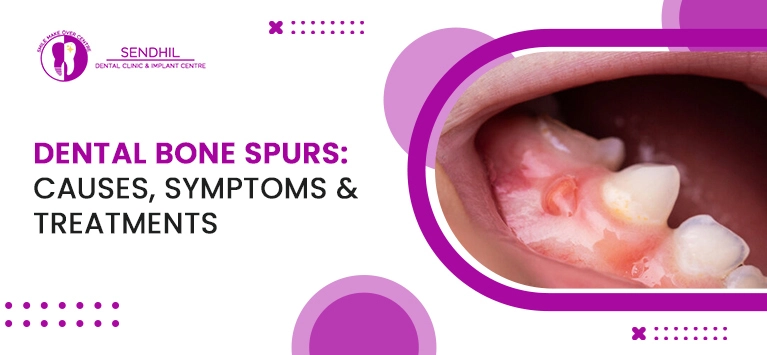
Understanding Dental Bone Spurs: Causes, Symptoms, Treatment
Dental health is an essential part for overall well-being. However, one lesser-known issue that can affect dental health is the development of dental bone spurs. Dental bone spurs, also called exostoses or osteophytes, can form on the jaw bone and have several effects.
Table of Contents
What Are Dental Bone Spurs?
Dental bone spurs are small bony growths that can develop in the bones of the mouth, primarily the jaw. They are similar to bone spurs that arise in other areas of the body, such as the spine, knees, or hips. Though bone spurs can be visible in any area of the body, bone spur in teeth are concerning because they may impact our oral function and may cause pain.
Causes of Dental Bone Spurs
The reason for experiencing dental bone spurs is occasionally challenging to identify precisely, but various factors could be involved in their development, such as:
- Trauma or Injury: Trauma or injury to the teeth or jaw bone from dental procedures, formation of bone spurs after tooth extraction, or accidents can result in the development of bone spurs in teeth. At the same time, the body attempts to restore itself to its original condition.
- Dental Extraction: It is easy to form bone spur after tooth extraction; Bone spurs can develop as the body tries to heal itself, especially if the extraction is complex. The body may try to fill in the space left by the extracted tooth too aggressively.
- Orthodontic Procedures: The pressure from braces or other orthodontic devices can stimulate the jawbone to grow new bone, which can result in bone spicule in the mouth.
- Infections: If there is an infection in the jawbone or the gums, this can lead to swelling at the site of the infection and, subsequently, spur formation.
- Genetic Predisposition: Some people are more inclined to develop bone spurs than others due to their genetic makeup.
- Age-Related Changes: Due to changes in bone structure and density as you age, bone spurs may develop.
Symptoms of Dental Bone Spurs
Some dental bone spurs don’t cause any noticeable symptoms. But when they do, the following symptoms may appear:
- Pain and Discomfort: From mild to severe pain, especially while chewing or talking.
- Swelling and Redness: The area surrounding the spur may swell and become inflamed.
- Ulcers and Sores: The Bone spicule in the mouth can rub against the soft tissues in the mouth, causing irritation and leading to ulcers or sores.
- Chewing Difficulty: Bone spurs can interfere with chewing by making it difficult or uncomfortable due to pain.
- Rough Mouth: Bone spurs can create sharp or bumpy areas in the mouth, which can be noticeable when running the tongue over the area.
- Loose Teeth: In severe cases, bone spurs can weaken the stability of adjacent teeth, leading to their loosening.
Diagnosis of Dental Bone Spurs
If you have a bony growth in your jawbone (dental bone spur), it’s crucial to see a dentist or oral surgeon as soon as possible.
They can figure out if you have a bone spur by:
- Checking your mouth closely: They’ll look for any signs of a bone spur.
- Taking X-rays and other pictures: These tests can show a clear view of your jawbone, including any bone spurs.
Treatment Options for Dental Bone Spurs
The treatment for dental bone spicule varies depending on the symptoms and cause:
- Monitoring: If the bone spur is not causing significant issues, the dentist might monitor it over time.
- Medications: Pain relievers and anti-inflammatory drugs can ease symptoms. Antibiotics can be used if an infection is present.
- Mouth Rinses: Antiseptic mouthwashes help reduce inflammation and prevent infection in the area with the bone spur.
- Smoothing the Bump: Dentists might gently scrape the bone spur with special tools to make it less painful and irritating.
- Surgery to Remove: If the dental bone spicule causes too much pain or affects how the teeth work, it may need to be removed with surgery. An oral surgeon usually does this surgery by numbing the area and cutting out the bump.
- Treating Other Problems: To stop bone spurs from coming back, it’s essential to treat any underlying issues, like gum disease or infections.
Prevention of Dental Bone Spurs
To lower the risk of dental bone spurs, consider these preventive measures:
- Maintain Good Oral Hygiene: Proper brushing and flossing prevent infections and gum disease, which can trigger bone spur development.
- Schedule Regular Dental Check-ups: Early detection and treatment of dental problems can minimize the chances of bone spur formation.
- Use Protective Gear: Wearing mouthguards during physical activities can protect your jaw from injuries that could lead to bone spurs.
- Healthy Diet: Eating a balanced diet with plenty of vitamins and minerals is essential for maintaining strong bones and preventing bone problems.
- Dental Care: Getting dental problems fixed right away, like removing teeth or getting braces, can help prevent issues that can lead to bone spurs growing.
Conclusion
Bone spurs in the mouth, despite being less discussed, can seriously affect your dental health. It’s essential to be aware of what causes them, what they feel like, and how they can be treated to manage them better. If you suspect you may have dental bone spicule, it’s crucial to seek professional dental advice to address the issue and prevent any worsening. By practicing good dental habits and scheduling regular dental check-ups, you can maintain a healthy mouth and minimize the chances of developing bone spurs.




